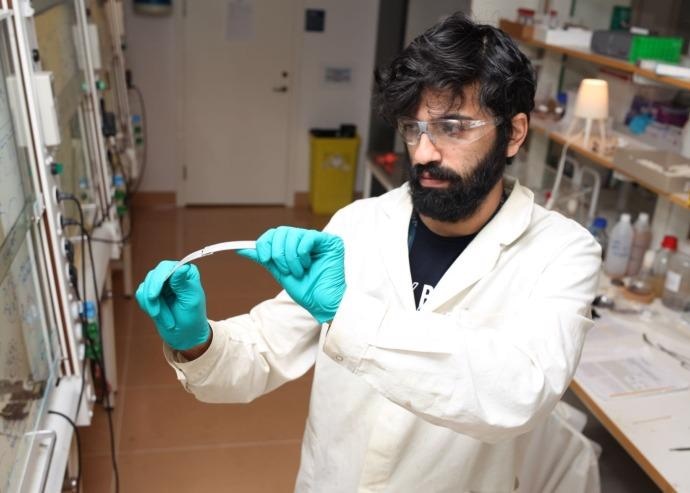Reviewed by Alex SmithNov 25 2021
At Stockholm University, scientists have come up with a resource-efficient technique to generate new lignin-based materials that can be reprocessed thermally and further utilized to replace adhesives and thermosetting resins.

MSc Mohammad Morsali, one of the researchers behind the study, shows the adhesive strength of the lignin-based material by bending the bonded aluminum plates. Image Credit: Mika Sipponen.
There is a need for modern societies to determine alternatives to materials that are derived from gas resources and fossil oil. At the same time, there is an immediate requirement to develop enabling technologies for a transition to a sustainable circular economy.
For instance, thermosetting resins provide strong performance in today’s exacting applications, but unluckily these synthetic plastics cannot be easily recycled. The team utilized lignin as the renewable raw material in a catalyst-free reaction with a non-toxic chemical derived from ethylene glycol.
Lignin is a by-product obtained from the pulp and paper industry, where it is primarily burned to recover heat and chemicals. But there is a strong push to utilize lignin as a building block for new value-added materials that act as carbon stocks during their lifespan.
We were amazed by the performance of the new materials, and one of the striking aspects of our results is the simplicity and material efficiency of the synthetic process. In contrast to earlier examples, we do not need any chemical modification or fractionation of the lignin but can simply cook it with the cross-linker in a one-pot reaction.
Dr Adrian Moreno, Stockholm University
Dr. Adrian Moreno from Stockholm University, who is one of the researchers associated with the study, explains that the outcome is a black and plastic-like material that can be cast into multiple shapes with the help of traditional techniques like injection molding.
The latest lignin-based materials can be utilized multiple times, which is key to circular materials of the future. The team demonstrated this by quantifying the mechanical strength of the pristine material as such and also from the same material that was reprocessed from the fractured sample. The mechanical strength was similar to that of engineered plastics and remained unaltered following the reprocessing.
From Single-Use to Recoverable Adhesives
Furthermore, the researchers found that the performance of the material could be customized from hard and brittle to soft and tough just by altering the amount of lignin utilized in the formulation.
The ability to tune the material properties opens many opportunities to commercial applications. For example, the formulation containing 50 percent of lignin by weight is an excellent adhesive for several types of soft and hard materials. It is possible to recover the adhesive or simply detach the material and glue it again at mild temperatures comparable to those that are used in the kitchen oven.
Mohammad Morsali, Study Author and PhD Student, Stockholm University
Lignin is known to be one of nature’s wonder materials, gaining attention as a candidate for advanced materials only recently.
This is an excellent demonstration of the possibilities that lignin holds as a valuable feedstock. The material that we developed is perfectly in line with the current move towards sustainable circular materials. Owing to its design consisting of so-called dynamic covalent bonds, the material can be formed over and over again by relatively mild heating.
Mika Sipponen, Assistant Professor, Stockholm University
A Bright Future for Sustainable Materials
The current shift towards renewable and circular materials poses a significant challenge as a large majority of the materials people use in the everyday life is still made of fossil building blocks.
Mika Sipponen notes that there will also be several chances for involving students in the research projects, particularly now that Stockholm University has started a new MSc program in Sustainable Chemistry. Meanwhile, there are fascinating initiatives like the Stockholm University Center for Circular and Sustainable Systems, SUCCeSS. This opens new chances for innovative materials chemistry.
Mika Sipponen stated, “We see a great opportunity in this paradigm shift to phase out the fossil materials. It is evident that fresh ideas and collaboration across disciplines are needed to harness the true potential of lignin and other sustainable materials and eventually commercialize them.”
It is this multifaceted feature of the study that drives the researchers to strive to resolve a few of the major difficulties that are facing today’s generation.
The study has been reported in ACS Applied Materials & Interfaces on November 24th, 2021.
Journal Reference:
Moreno, A., et al. (2021) Catalyst-Free Synthesis of Lignin Vitrimers with Tunable Mechanical Properties: Circular Polymers and Recoverable Adhesives. ACS Applied Materials & Interfaces. doi.org/10.1021/acsami.1c17412.